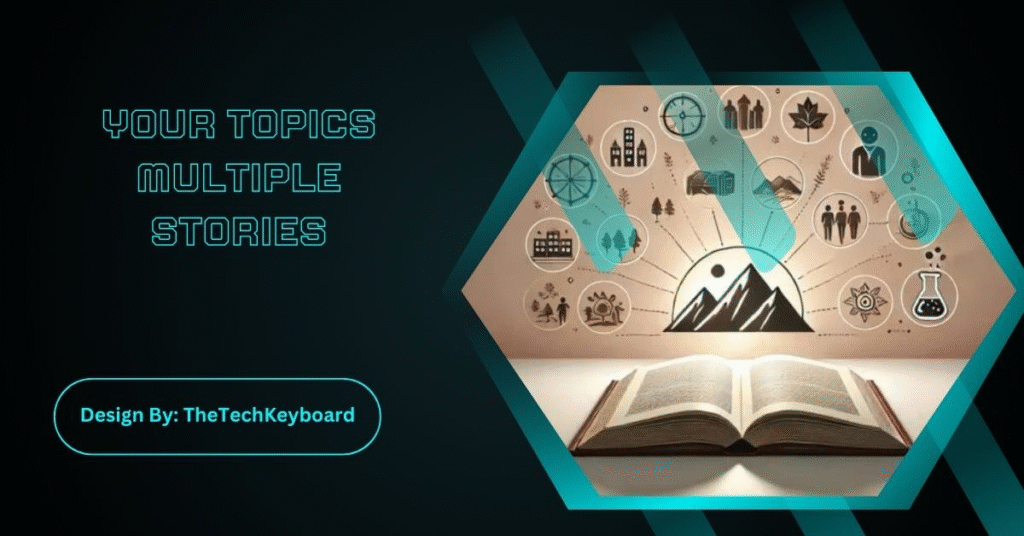Your Topics | Multiple Stories: A Creative Journey Through Diverse Narratives

In the your topics | multiple stories world of storytelling, the canvas is as wide as your imagination. Your Topics | Multiple Stories isn’t just a phrase—it’s a declaration of creative freedom. It represents the idea of exploring various themes, emotions, and perspectives through multiple narrative arcs, each rooted in your own passions or experiences. Whether you’re a fiction writer crafting different worlds, a blogger sharing a series of life stories, or an entrepreneur using storytelling to connect with audiences, exploring multiple topics can make your work more dynamic and impactful.
This concept emphasizes that you’re not limited to one genre or perspective. By drawing from your personal reservoir of ideas and experiences, you can produce a range of engaging narratives that reflect the complexity of real life. In this article, we’ll explore the power behind personal topics, how to effectively manage multiple storylines, tips on blending your topics | multiple stories genres, organizing your content, and publishing strategies to bring your storytelling to the world. Whether you’re a beginner or seasoned writer, this guide offers a roadmap to creating multi-dimensional content that resonates with diverse audiences.
The Power of Personal Topics in Storytelling
Every great story begins with a seed—a moment, an emotion, a curiosity. When writers tap into their own experiences or deep interests, their narratives become more authentic and emotionally resonant. Personal topics often hold powerful truths and raw emotions that captivate readers because they reflect real, relatable moments. Whether it’s a story about your topics | multiple stories overcoming adversity or a whimsical tale based on childhood dreams, writing from within allows your voice to stand out in a crowded landscape.
Moreover, personal topics serve as a springboard for creativity. They allow you to write with authority and confidence because you know the subject intimately. This connection enhances the emotional depth of your characters and the sincerity of your narrative. Readers can feel when a story is written from the heart—they’re more likely to engage with your work and share it with others.
From Maya Angelou to Stephen King, many successful authors have built legacies on stories inspired by personal themes. Their characters often your topics | multiple stories mirror their own challenges, fears, and triumphs. Writing from your own experiences doesn’t limit your creative reach; instead, it empowers you to approach storytelling with a richer understanding of human emotion and purpose.
Exploring Multiple Storylines: Techniques and Approaches

Writing multiple stories under one umbrella might sound overwhelming at first, but with the right techniques, it becomes an enriching creative exercise. There are many ways to explore multiple storylines effectively. One approach is the linear storyline, where different stories unfold sequentially and may eventually intersect. This is commonly seen in epic novels or TV series where subplots add layers to the main narrative.
Another effective structure is nonlinear or parallel storytelling, where narratives run simultaneously, often shifting between characters or timelines. This your topics | multiple stories technique keeps readers intrigued as they piece together the connections. Books like Cloud Atlas and movies like Pulp Fiction are excellent examples of this style.
You might also consider a multi-perspective approach, giving voice to different characters who experience the same events from various viewpoints. This adds depth to your narrative and can spark empathy in your readers by showcasing how perspective influences perception.
Regardless of structure, clarity is key. Multiple storylines should complement rather than confuse each other. Transitions must be smooth, and themes should be threaded consistently throughout. When done well, multiple storylines can deliver a powerful punch—presenting contrasting ideas, building suspense, and enriching character development.
Blending Genres and Themes
Genre fusion is where your creativity can truly shine. By blending genres, you open the door to fresh narratives that defy conventions. Imagine combining the thrill of a detective mystery with the warmth of a coming-of-age story, or mixing sci-fi elements your topics | multiple stories with historical fiction. These combinations keep readers on their toes and add a layer of originality to your storytelling.
However, genre blending requires balance. Each genre has specific tropes and reader expectations, and your goal is to satisfy those while still innovating. It’s important to ensure that one genre doesn’t overpower the other unless intended. For example, if your story is primarily a romance with fantasy elements, those magical aspects should enhance the romance rather than dominate the plot.
Themes, on the other hand, provide the emotional and philosophical backbone of your work. Whether your stories explore justice, identity, love, or fear, a strong thematic thread unifies them. In multi-story narratives, each story can represent a different facet of a core theme, enriching the reader’s understanding.
Audience consideration is essential here. Diverse themes attract varied readers, but cohesion is key to keeping them engaged. Successfully blending genres and your topics | multiple stories themes not only stretches your creative muscles but also helps you stand out in an increasingly competitive market.
Organizing and Structuring a Multi-Topic Manuscript
One of the most challenging aspects of writing multiple stories is organization. Without a clear structure, even the best ideas can become chaotic. The first step is creating an outline that maps out each story’s arc, characters, and key events. Software like Scrivener or Notion can help writers visually track storylines and transitions.
Decide how you want to present the stories. Will they appear in chronological order, or based on thematic progression? Are your topics | multiple stories they interconnected through characters or settings, or do they stand alone? Collections like The Things They Carried by Tim O’Brien masterfully link stories with a recurring protagonist and shared themes, while anthologies like Interpreter of Maladies present entirely separate tales tied by cultural experience.
Consistency is another critical element. Even if your stories vary in tone or setting, maintaining a unified voice helps ground the reader. Revisit your stories regularly to check for narrative coherence and thematic continuity.
Lastly, don’t underestimate the power of chapter titles, section breaks, and visual cues. These structural elements provide natural pauses and help readers reorient themselves when shifting between narratives. A well-structured manuscript ensures your multi-topic content is not only creative but also polished and professional.
Publishing and Marketing a Multi-Story Project
Publishing a project with multiple your topics | multiple stories stories presents unique opportunities and challenges. Traditional publishers might prefer single-topic works due to market predictability, but this is changing. Anthologies and multi-story collections are gaining popularity, especially in literary and indie markets. Consider researching publishers that specialize in short stories or thematic anthologies, or explore small presses open to unconventional formats.
Self-publishing offers greater flexibility and creative control. You can design your book layout, publish in parts, or even offer individual stories as digital your topics | multiple stories downloads. Platforms like Amazon Kindle Direct Publishing (KDP), Wattpad, and Substack are powerful tools for reaching readers directly.
Marketing your work requires a strategic approach. Highlight the diversity of stories as a strength—appealing to different audiences through targeted promotions. For instance, if your collection includes a horror story and a love story, tailor your ads and blurbs to each genre’s fanbase. Use social media to share story excerpts, character insights, and behind-the-scenes writing processes to build community engagement.
With the right platform and promotion, your multi-topic project can capture a wide and appreciative audience. The key is confidence in your your topics | multiple stories unique voice and strategic storytelling that binds everything together.
Conclusion
Your Topics | Multiple Stories is more than a storytelling method—it’s a creative declaration. It allows you to stretch beyond one narrative, one emotion, or one idea. Through personal topics, layered storylines, blended genres, and strategic organization, you can craft a rich, multifaceted literary work that resonates across demographics and genres.
Every story you write becomes a chapter of your voice, your journey, your vision. Don’t limit yourself to one path when many roads await exploration. With the right tools and mindset, your multiple stories can become a powerful literary tapestry, woven with your topics | multiple stories meaning, diversity, and emotional truth.
FAQs
Q1: How do I choose which personal topics to write about?
Start with what moves you. Think of moments that have shaped your life or questions you often ponder. Passion and authenticity should guide your choice.
Q2: Can multiple short stories be part of one novel or collection?
Yes. Many novels and anthologies are built around interconnected or standalone short stories that share themes, settings, or characters.
Q3: What is the best way to maintain consistency across different stories?
Create a story bible—a document that outlines themes, tone, voice, and recurring elements. Revisit it regularly during editing.
Q4: Are there genres that work better with multiple storylines?
Genres like drama, sci-fi, historical fiction, and literary fiction often lend themselves well to multiple narratives due to their complexity and scope.
Q5: How do publishers view manuscripts with diverse topics?
Some publishers welcome innovative structures. Others may be hesitant. Research publishers who specialize in anthologies or experimental fiction.
Q6: Should I use one main character across all stories, or multiple protagonists?
Both approaches can work. It depends on your thematic goals and how interconnected you want your narratives to be.
Q7: What are common mistakes to avoid in multi-topic storytelling?
Lack of cohesion, inconsistent tone, underdeveloped characters, and poor transitions are common pitfalls. Careful planning helps avoid them.
You May Also Read: https://ventswork.com/luxury-villas-italy-le-collectionist/



